+ Open data
Open data
- Basic information
Basic information
| Entry | Database: PDB / ID: 1q4l | ||||||
|---|---|---|---|---|---|---|---|
| Title | GSK-3 Beta complexed with Inhibitor I-5 | ||||||
 Components Components | GLYCOGEN SYNTHASE KINASE-3 BETA | ||||||
 Keywords Keywords | TRANSFERASE / KINASE / INSULIN PATHWAY | ||||||
| Function / homology |  Function and homology information Function and homology informationneuron projection organization / regulation of microtubule anchoring at centrosome / negative regulation of type B pancreatic cell development / negative regulation of glycogen (starch) synthase activity / negative regulation of mesenchymal stem cell differentiation / superior temporal gyrus development / positive regulation of protein localization to cilium / negative regulation of glycogen biosynthetic process / negative regulation of TORC2 signaling / negative regulation of dopaminergic neuron differentiation ...neuron projection organization / regulation of microtubule anchoring at centrosome / negative regulation of type B pancreatic cell development / negative regulation of glycogen (starch) synthase activity / negative regulation of mesenchymal stem cell differentiation / superior temporal gyrus development / positive regulation of protein localization to cilium / negative regulation of glycogen biosynthetic process / negative regulation of TORC2 signaling / negative regulation of dopaminergic neuron differentiation / maintenance of cell polarity / positive regulation of protein localization to centrosome / positive regulation of cilium assembly / beta-catenin destruction complex / CRMPs in Sema3A signaling / heart valve development / tau-protein kinase / APC truncation mutants have impaired AXIN binding / AXIN missense mutants destabilize the destruction complex / Truncations of AMER1 destabilize the destruction complex / regulation of microtubule-based process / regulation of protein export from nucleus / Beta-catenin phosphorylation cascade / Signaling by GSK3beta mutants / CTNNB1 S33 mutants aren't phosphorylated / CTNNB1 S37 mutants aren't phosphorylated / CTNNB1 S45 mutants aren't phosphorylated / CTNNB1 T41 mutants aren't phosphorylated / positive regulation of mitochondrial outer membrane permeabilization involved in apoptotic signaling pathway / cellular response to interleukin-3 / Maturation of nucleoprotein / Wnt signalosome / regulation of long-term synaptic potentiation / negative regulation of TOR signaling / negative regulation of protein localization to nucleus / Disassembly of the destruction complex and recruitment of AXIN to the membrane / AKT phosphorylates targets in the cytosol / negative regulation of calcineurin-NFAT signaling cascade / regulation of axon extension / Maturation of nucleoprotein / tau-protein kinase activity / negative regulation of epithelial to mesenchymal transition / G protein-coupled dopamine receptor signaling pathway / positive regulation of cell-matrix adhesion / regulation of axonogenesis / regulation of dendrite morphogenesis / glycogen metabolic process / ER overload response / regulation of neuron projection development / Constitutive Signaling by AKT1 E17K in Cancer / establishment of cell polarity / protein kinase A catalytic subunit binding / dynactin binding / epithelial to mesenchymal transition / Regulation of HSF1-mediated heat shock response / NF-kappaB binding / canonical Wnt signaling pathway / negative regulation of osteoblast differentiation / positive regulation of protein binding / negative regulation of protein-containing complex assembly / negative regulation of extrinsic apoptotic signaling pathway via death domain receptors / regulation of cellular response to heat / extrinsic apoptotic signaling pathway / cellular response to retinoic acid / extrinsic apoptotic signaling pathway in absence of ligand / positive regulation of autophagy / presynaptic modulation of chemical synaptic transmission / Transcriptional and post-translational regulation of MITF-M expression and activity / regulation of microtubule cytoskeleton organization / response to endoplasmic reticulum stress / negative regulation of cell migration / positive regulation of protein export from nucleus / positive regulation of protein ubiquitination / Ubiquitin-dependent degradation of Cyclin D / excitatory postsynaptic potential / mitochondrion organization / hippocampus development / positive regulation of cell differentiation / positive regulation of protein-containing complex assembly / GSK3B and BTRC:CUL1-mediated-degradation of NFE2L2 / negative regulation of canonical Wnt signaling pathway / Degradation of GLI2 by the proteasome / GLI3 is processed to GLI3R by the proteasome / circadian rhythm / regulation of circadian rhythm / Degradation of beta-catenin by the destruction complex / beta-catenin binding / peptidyl-serine phosphorylation / B-WICH complex positively regulates rRNA expression / tau protein binding / Wnt signaling pathway / cellular response to amyloid-beta / neuron projection development / Regulation of RUNX2 expression and activity / positive regulation of protein catabolic process / p53 binding / kinase activity / insulin receptor signaling pathway / positive regulation of proteasomal ubiquitin-dependent protein catabolic process / positive regulation of neuron apoptotic process Similarity search - Function | ||||||
| Biological species |  Homo sapiens (human) Homo sapiens (human) | ||||||
| Method |  X-RAY DIFFRACTION / X-RAY DIFFRACTION /  SYNCHROTRON / SYNCHROTRON /  MOLECULAR REPLACEMENT / Resolution: 2.77 Å MOLECULAR REPLACEMENT / Resolution: 2.77 Å | ||||||
 Authors Authors | Bertrand, J.A. / Thieffine, S. / Vulpetti, A. / Cristiani, C. / Valsasina, B. / Knapp, S. / Kalisz, H.M. / Flocco, M. | ||||||
 Citation Citation |  Journal: J.Mol.Biol. / Year: 2003 Journal: J.Mol.Biol. / Year: 2003Title: Structural Characterization of the Gsk-3Beta Active Site Using Selective and Non-selective ATP-Mimetic Inhibitors Authors: Bertrand, J.A. / Thieffine, S. / Vulpetti, A. / Cristiani, C. / Valsasina, B. / Knapp, S. / Kalisz, H.M. / Flocco, M. | ||||||
| History |
|
- Structure visualization
Structure visualization
| Structure viewer | Molecule:  Molmil Molmil Jmol/JSmol Jmol/JSmol |
|---|
- Downloads & links
Downloads & links
- Download
Download
| PDBx/mmCIF format |  1q4l.cif.gz 1q4l.cif.gz | 149.2 KB | Display |  PDBx/mmCIF format PDBx/mmCIF format |
|---|---|---|---|---|
| PDB format |  pdb1q4l.ent.gz pdb1q4l.ent.gz | 116.5 KB | Display |  PDB format PDB format |
| PDBx/mmJSON format |  1q4l.json.gz 1q4l.json.gz | Tree view |  PDBx/mmJSON format PDBx/mmJSON format | |
| Others |  Other downloads Other downloads |
-Validation report
| Summary document |  1q4l_validation.pdf.gz 1q4l_validation.pdf.gz | 1.2 MB | Display |  wwPDB validaton report wwPDB validaton report |
|---|---|---|---|---|
| Full document |  1q4l_full_validation.pdf.gz 1q4l_full_validation.pdf.gz | 1.2 MB | Display | |
| Data in XML |  1q4l_validation.xml.gz 1q4l_validation.xml.gz | 27.5 KB | Display | |
| Data in CIF |  1q4l_validation.cif.gz 1q4l_validation.cif.gz | 36.6 KB | Display | |
| Arichive directory |  https://data.pdbj.org/pub/pdb/validation_reports/q4/1q4l https://data.pdbj.org/pub/pdb/validation_reports/q4/1q4l ftp://data.pdbj.org/pub/pdb/validation_reports/q4/1q4l ftp://data.pdbj.org/pub/pdb/validation_reports/q4/1q4l | HTTPS FTP |
-Related structure data
| Related structure data |  1pyxC 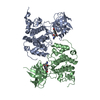 1q3dC  1q3wC  1q41C  1h8fS C: citing same article ( S: Starting model for refinement |
|---|---|
| Similar structure data |
- Links
Links
- Assembly
Assembly
| Deposited unit | 
| ||||||||
|---|---|---|---|---|---|---|---|---|---|
| 1 |
| ||||||||
| Unit cell |
|
- Components
Components
| #1: Protein | Mass: 47081.473 Da / Num. of mol.: 2 Source method: isolated from a genetically manipulated source Source: (gene. exp.)  Homo sapiens (human) / Gene: GSK3B / Plasmid: PVL-GST-GSK3BETA / Cell line (production host): H5 / Production host: Homo sapiens (human) / Gene: GSK3B / Plasmid: PVL-GST-GSK3BETA / Cell line (production host): H5 / Production host:  #2: Chemical | #3: Water | ChemComp-HOH / | |
|---|
-Experimental details
-Experiment
| Experiment | Method:  X-RAY DIFFRACTION / Number of used crystals: 1 X-RAY DIFFRACTION / Number of used crystals: 1 |
|---|
- Sample preparation
Sample preparation
| Crystal | Density Matthews: 3.46 Å3/Da / Density % sol: 64.42 % | |||||||||||||||||||||||||||||||||||||||||||||||||||||||||||||||
|---|---|---|---|---|---|---|---|---|---|---|---|---|---|---|---|---|---|---|---|---|---|---|---|---|---|---|---|---|---|---|---|---|---|---|---|---|---|---|---|---|---|---|---|---|---|---|---|---|---|---|---|---|---|---|---|---|---|---|---|---|---|---|---|---|
| Crystal grow | Temperature: 298 K / Method: vapor diffusion, hanging drop / pH: 7 Details: PEG 3350 MONODISPERSE, GLYCEROL, MAGNESIUM CHLORIDE, HEPES, pH 7.00, VAPOR DIFFUSION, HANGING DROP, temperature 298K | |||||||||||||||||||||||||||||||||||||||||||||||||||||||||||||||
| Crystal grow | *PLUS Temperature: 20 ℃ / pH: 7.2 / Method: vapor diffusion, hanging drop | |||||||||||||||||||||||||||||||||||||||||||||||||||||||||||||||
| Components of the solutions | *PLUS
|
-Data collection
| Diffraction | Mean temperature: 100 K |
|---|---|
| Diffraction source | Source:  SYNCHROTRON / Site: SYNCHROTRON / Site:  ESRF ESRF  / Beamline: ID14-4 / Wavelength: 0.9393 / Wavelength: 0.9393 Å / Beamline: ID14-4 / Wavelength: 0.9393 / Wavelength: 0.9393 Å |
| Detector | Type: ADSC QUANTUM 4 / Detector: CCD / Date: Mar 12, 2002 |
| Radiation | Protocol: SINGLE WAVELENGTH / Monochromatic (M) / Laue (L): M / Scattering type: x-ray |
| Radiation wavelength | Wavelength: 0.9393 Å / Relative weight: 1 |
| Reflection | Resolution: 2.77→30 Å / Num. obs: 33530 / % possible obs: 98.5 % / Redundancy: 3.164 % / Biso Wilson estimate: 37.6 Å2 / Rsym value: 0.093 / Net I/σ(I): 10.8231 |
| Reflection shell | Resolution: 2.77→2.87 Å / Mean I/σ(I) obs: 1.893 / Rsym value: 0.569 / % possible all: 99.6 |
| Reflection | *PLUS Highest resolution: 2.77 Å / Num. measured all: 106100 / Rmerge(I) obs: 0.093 |
| Reflection shell | *PLUS % possible obs: 99.6 % / Rmerge(I) obs: 0.569 / Mean I/σ(I) obs: 1.9 |
- Processing
Processing
| Software |
| ||||||||||||||||||||
|---|---|---|---|---|---|---|---|---|---|---|---|---|---|---|---|---|---|---|---|---|---|
| Refinement | Method to determine structure:  MOLECULAR REPLACEMENT MOLECULAR REPLACEMENTStarting model: PDB ENTRY 1H8F Resolution: 2.77→20 Å / Rfactor Rfree error: 0.006 / Data cutoff high absF: 1694956.14 / Data cutoff high rms absF: 1694956.14 / Data cutoff low absF: 0 / Isotropic thermal model: GROUP / Cross valid method: THROUGHOUT / σ(F): 0
| ||||||||||||||||||||
| Solvent computation | Solvent model: FLAT MODEL / Bsol: 32.3496 Å2 / ksol: 0.310392 e/Å3 | ||||||||||||||||||||
| Displacement parameters | Biso mean: 53.9 Å2
| ||||||||||||||||||||
| Refine analyze |
| ||||||||||||||||||||
| Refinement step | Cycle: LAST / Resolution: 2.77→20 Å
| ||||||||||||||||||||
| Refine LS restraints |
| ||||||||||||||||||||
| LS refinement shell | Resolution: 2.77→2.94 Å / Rfactor Rfree error: 0.021 / Total num. of bins used: 6
| ||||||||||||||||||||
| Xplor file |
| ||||||||||||||||||||
| Refinement | *PLUS Lowest resolution: 30 Å | ||||||||||||||||||||
| Solvent computation | *PLUS | ||||||||||||||||||||
| Displacement parameters | *PLUS | ||||||||||||||||||||
| Refine LS restraints | *PLUS
|
 Movie
Movie Controller
Controller



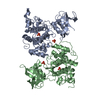
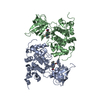

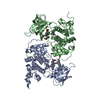

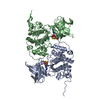

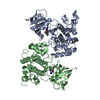

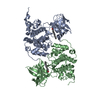
 PDBj
PDBj









